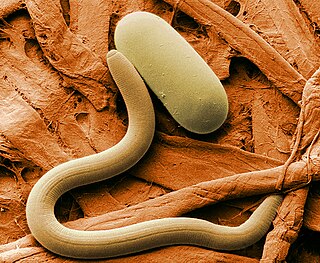Heterodera cajani is a plant pathogenic nematode affecting pigeonpeas, which is cited as an invasive species.
Heterodera cruciferae is a plant pathogenic nematode that predates on cabbages.
Heterodera filipjevi is a plant pathogenic nematode affecting barley.
Heterodera goettingiana, the pea cyst nematode, is a plant pathogenic nematode affecting peas.
Heterodera latipons, the Mediterranean cereal cyst nematode or wheat cyst nematode, is a plant pathogenic nematode.

Heterodera schachtii, the beet cyst eelworm or sugarbeet nematode, is a plant pathogenic nematode. It infects more than 200 different plants including economically important crops such as sugar beets, cabbage, broccoli, and radish. H. schachtii is found worldwide. Affected plants are marked by stunted growth, wilting, yellowing, decreased yields, and death. While there are many methods of control, crop rotation with non-susceptible plants is preferred.
Heterodera trifolii is a plant pathogenic nematode.

Heterodera is a genus of nematodes in the family Heteroderidae. Members of the genus are obligate parasites and different species attack different crops, often causing great economic damage. The genus is unique among nematode genera because of the ability of the female to transform into a tough, brown, cyst which protects the eggs which have been formed within her body. The name heterodera "refers to the different 'skins' of female and cyst."
Heterodera sacchari, the sugarcane cyst nematode, mitotic parthenogenic sedentary endoparasitic nematode. This plant-parasitic nematode infects the roots of sugarcane, and the female nematode eventually becomes a thick-walled cyst filled with eggs. Aboveground symptoms are species specific and are similar to those caused by other Heterodera species. Symptoms include: stunted and chlorotic plants, and reduced root growth. Seedlings may be killed in heavily infested soils.
Cereal cyst nematode (CCN) is a plant pest caused by Heterodera avenae, Heterodera bifenestra, Heterodera hordecalis, Heterodera latipons, and Heterodera gotland in the following hosts: Avena sativa, Hordeum vulgare, Secale cereale, Triticum aestivum, and × Triticosecale.
Heterodera bifenestra is a plant pathogenic nematode, that is a causal agent of the cereal cyst nematode.
Heterodera canadensis is a plant pathogenic nematode.
Heterodera cardiolata is a plant pathogenic nematode.
Heterodera oryzae, the rice cyst nematode, is a plant pathogenic nematode, which is cited as an invasive species.
Heterodera oryzicola, the rice cyst nematode, is a plant pathogenic nematode, which is cited as an invasive species.
Heterodera delvii is a plant pathogenic nematode, who is cited as an invasive species.
Heterodera elachista, the Japanese cyst nematode or rice cyst nematode, is a plant pathogenic nematode, which is cited as an invasive species.
Heterodera zeae, the corn cyst nematode (CCN), is a plant parasitic nematode that feeds on Zea mays (maize/corn). The CCN has a limited economic impact worldwide due to its high soil temperature requirements.
Pasteuria nishizawae is a mycelial and endospore-forming bacterium parasitic on cyst nematodes of genera Heterodera and Globodera.

